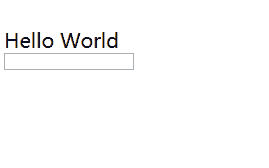- A+
所属分类:.NET技术
在应用开发过程中,经常遇到这样的需求:通过关键字查找数据,把带有关键字的数据显示出来,同时在结果中高亮显示关键字。在web开发中,只需在关键字上加一层标签,然后设置标签样式就可以轻松实现。
在WPF中显示文本内容通常采用TextBlock控件,也可以采用类似的方式,通过内联流内容元素Run达到同样的效果:
<TextBlock FontSize="20"> <Run Text="Hel" /><Run Foreground="Red" Text="lo " /><Run Text="Word" /> </TextBlock> 需要注意的是每个
Run之间不要换行,如果换行的话,每个Run之间会有间隙,看起来像增加了空格。
通过这种方式实现查找结果中高亮关键字,需要把查找结果拆分成三部分,然后绑定到Run元素的Text属性,或者在后台代码中使用TextBlock的Inlines属性添加Run元素
textBlock1.Inlines.Add(new Run("hel")); textBlock1.Inlines.Add(new Run("lo ") { Foreground=new SolidColorBrush(Colors.Red)}); textBlock1.Inlines.Add(new Run("world")); 这种方法虽然可以达到效果,但显然与MVVM的思想不符。接下来本文介绍一种通过附加属性实现TextBlock中指定内容高亮。

技术要点与实现
通过TextEffect的PositionStart、PositionCount以及Foreground属性设置字符串中需要高亮内容的起始位置、长度以及高亮颜色。定义附加属性允许TextBlock设置需要高亮的内容位置以及颜色。
- 首先定义类
ColoredLettering(并不要求继承DependencyObject)。 - 在
ColoredLettering中注册自定义的附加属性,注册附加属性方式与注册依赖属性类似,不过附加属性是用DependencyProperty.RegisterAttached来注册。 - 给附加属性注册属性值变化事件,事件处理逻辑中设置
TextEffect的PositionStart、PositionCount以及Foreground实现内容高亮。
public class ColoredLettering { public static void SetColorStart(TextBlock textElement, int value) { textElement.SetValue(ColorStartProperty, value); } public static int GetColorStart(TextBlock textElement) { return (int)textElement.GetValue(ColorStartProperty); } // Using a DependencyProperty as the backing store for ColorStart. This enables animation, styling, binding, etc... public static readonly DependencyProperty ColorStartProperty = DependencyProperty.RegisterAttached("ColorStart", typeof(int), typeof(ColoredLettering), new FrameworkPropertyMetadata(0, OnColorStartChanged)); private static void OnColorStartChanged(DependencyObject d, DependencyPropertyChangedEventArgs e) { TextBlock textBlock = d as TextBlock; if (textBlock != null) { if (e.NewValue == e.OldValue) return; if (e.NewValue is int) { int count = GetColorLength(textBlock); Brush brush = GetForeColor(textBlock); if ((int)e.NewValue <= 0 || count <= 0 || brush == TextBlock.ForegroundProperty.DefaultMetadata.DefaultValue) return; if (textBlock.TextEffects.Count != 0) { textBlock.TextEffects.Clear(); } TextEffect textEffect = new TextEffect() { Foreground = brush, PositionStart = (int)e.NewValue, PositionCount = count }; textBlock.TextEffects.Add(textEffect); } } } public static void SetColorLength(TextBlock textElement, int value) { textElement.SetValue(ColorLengthProperty, value); } public static int GetColorLength(TextBlock textElement) { return (int)textElement.GetValue(ColorLengthProperty); } // Using a DependencyProperty as the backing store for ColorStart. This enables animation, styling, binding, etc... public static readonly DependencyProperty ColorLengthProperty = DependencyProperty.RegisterAttached("ColorLength", typeof(int), typeof(ColoredLettering), new FrameworkPropertyMetadata(0, OnColorLengthChanged)); private static void OnColorLengthChanged(DependencyObject d, DependencyPropertyChangedEventArgs e) { TextBlock textBlock = d as TextBlock; if (textBlock != null) { if (e.NewValue == e.OldValue) return; if (e.NewValue is int) { int start = GetColorStart(textBlock); Brush brush = GetForeColor(textBlock); if ((int)e.NewValue <= 0 || start <= 0 || brush == TextBlock.ForegroundProperty.DefaultMetadata.DefaultValue) return; if (textBlock.TextEffects.Count != 0) { textBlock.TextEffects.Clear(); } TextEffect textEffect = new TextEffect() { Foreground = brush, PositionStart = start, PositionCount = (int)e.NewValue }; textBlock.TextEffects.Add(textEffect); } } } public static void SetForeColor(TextBlock textElement, Brush value) { textElement.SetValue(ColorStartProperty, value); } public static Brush GetForeColor(TextBlock textElement) { return (Brush)textElement.GetValue(ForeColorProperty); } // Using a DependencyProperty as the backing store for ForeColor. This enables animation, styling, binding, etc... public static readonly DependencyProperty ForeColorProperty = DependencyProperty.RegisterAttached("ForeColor", typeof(Brush), typeof(ColoredLettering), new PropertyMetadata(TextBlock.ForegroundProperty.DefaultMetadata.DefaultValue, OnForeColorChanged)); private static void OnForeColorChanged(DependencyObject d, DependencyPropertyChangedEventArgs e) { TextBlock textBlock = d as TextBlock; if (textBlock != null) { if (e.NewValue == e.OldValue) return; if (e.NewValue is Brush) { int start = GetColorStart(textBlock); int count = GetColorLength(textBlock); if (start <= 0 || count <= 0) return; if (textBlock.TextEffects.Count != 0) { textBlock.TextEffects.Clear(); } TextEffect textEffect = new TextEffect() { Foreground = (Brush)e.NewValue, PositionStart = start, PositionCount = count }; textBlock.TextEffects.Add(textEffect); } } } } 调用时只需在TextBlock指定需要高亮内容的开始位置,内容长度以及高亮颜色即可。
<TextBlock local:ColoredLettering.ColorLength="{Binding Count}" local:ColoredLettering.ColorStart="{Binding Start}" local:ColoredLettering.ForeColor="{Binding ForeColor}" FontSize="20" Text="Hello World" /> 总结
本文介绍的方法只是高亮第一个匹配到的关键字,如果需要高亮匹配到的所有内容,只需要对附加属性进行改造,以支持传入一组位置和颜色信息。
最后分享一个可以解析一组有限的HTML标记并显示它们的WPF控件HtmlTextBlock ,通过这个控件也可以实现查找结果中高亮关键字,甚至支持指定内容触发事件做一些逻辑操作。




